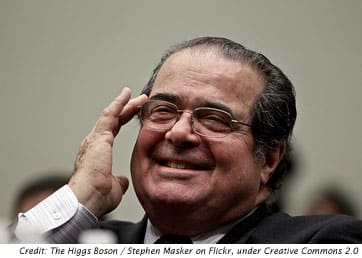
.jpg) (WOMENSENEWS)–Supporters of the Equal Rights Amendment should give U.S. Supreme Court Justice Antonin Scalia a standing ovation right about now.
(WOMENSENEWS)–Supporters of the Equal Rights Amendment should give U.S. Supreme Court Justice Antonin Scalia a standing ovation right about now.
In widely quoted comments in the current issue of California Lawyer, Scalia said the equal protection clause of the 14th Amendment to the Constitution does not protect against discrimination on the basis of gender.
That boils down to the idea that women are not part of the Constitution.
Bravo! That’s just what supporters of the Equal Rights Amendment, known as E.R.A., have been saying for years.
The E.R.A. is rather simple. It would guarantee the equality of rights under the law not be denied or abridged by the United States or by any state on account of sex. It gives Congress the power of enforcement.
Those who follow Scalia’s decisions barely raised an eyebrow at his latest comments. He showed his view on sex discrimination in 1996 when he cast the sole vote in favor of the Virginia Military Institute’s ability to discriminate against female applicants. Overall, his statements are less alarming than the media have trumpeted.
The 14th Amendment was ratified in 1868 as part of the Reconstruction Amendments and was the basis for the 1954 Brown v. Board of Education decision, leading to the dismantling of segregation laws in the South.
Support Not Universal
In recent decades, the Supreme Court applied the amendment to laws that discriminate against women, although support for this interpretation is not universal.
Other judges have not reinforced the application of the 14th Amendment to women’s rights.
The E.R.A. was introduced in 1923 into both houses of the U.S. Congress, which finally passed the legislation in 1972. Initially, ratification proved relatively easy as states rushed to approve the amendment.
Progress slowed by the late 1970s and growing forces rallied against its passage. The national fight for the E.R.A. was considered dead in 1982 when a ratification vote fell short by three states of the 38 states needed.
At that point, the seven-year time limit imposed by Congress had expired and all seemed lost.
But a legal strategy to revive the E.R.A. was developed after 1992, when Congress ratified the 27th Amendment to the Constitution 203 years after its passage, opening the way for a similar time frame for E.R.A. ratification.
In recent years, several states have added their own E.R.A. to their constitutions, and many of the arguments against the ratification, such as women in the military and same-sex marriage, are no longer relevant.
15 States Remain
 Currently, 15 states have not ratified the E.R.A. They are Alabama, Arizona, Arkansas, Florida, Georgia, Illinois, Louisiana, Mississippi, Missouri, Nevada, North Carolina, Oklahoma, South Carolina, Utah and Virginia.
Currently, 15 states have not ratified the E.R.A. They are Alabama, Arizona, Arkansas, Florida, Georgia, Illinois, Louisiana, Mississippi, Missouri, Nevada, North Carolina, Oklahoma, South Carolina, Utah and Virginia.
Since 1995, bills have been introduced in six of the unratified states. Proponents for the E.R.A. point out that every constitution in the world written after World War II includes an E.R.A.-like statement that men and women are equals.
Scalia’s colleague Justice Ruth Bader Ginsberg, a strong E.R.A. proponent, has urged citizens to lobby for the amendment’s passage.
"I would write the lawmakers of the United States in Congress and in the states to perfect the fundamental instrument of government in this regard for the sake of my daughter, my granddaughters and all the daughters in generations yet to come," she said in the 1998 documentary "The Equal Rights Amendment: Unfinished Business for the Constitution." "I would like to see in our Constitution this clarion statement of bedrock principle–equal rights shall not be denied or abridged on account of sex."
Would you like to Comment but not sure how? Visit our help page at https://womensenews.org/help-making-comments-womens-enews-stories.
Would you like to Send Along a Link of This Story?
https://womensenews.org/story/washington-outlookcongresswhite-house/110106/justice-scalia-makes-the-case-era-ratification
Kimberly Wilmot Voss, Ph.D., is an assistant professor in the Nicholson School of Communication at the University of Central Florida. She studies the media’s representation of women, including coverage of the Equal Rights Amendment.
For more information:
California Lawyer interview with Justice Scalia:
http://www.callawyer.com/story.cfm?eid=913358andevid=1


